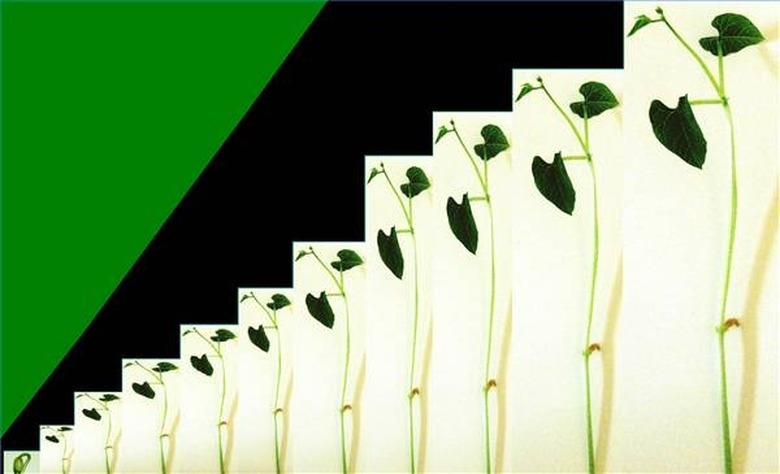How Do Living Things Grow?
Living things grow differently from non-living things. Inanimate things such as fires, lakes or hurricanes can grow, but they do so either by adding more of the material they are made of from the outside, or by growing to become more of the same material with the same characteristics. Lakes grow when they contain more water, and fires grow by becoming big fires with the same characteristics as smaller fires. Living things can grow bigger, too, but they grow in a controlled way to change their characteristics in a generally predictable way. Non-living things don't follow that same path.
TL;DR (Too Long; Didn't Read)
While non-living things can grow larger without changing their basic nature, living things grow in another way. Most living things need oxygen, water and food to grow. Plants are a special case because they produce their own food from a chemical reaction that takes place in light. Other living things eat plants or other animals for food. The cells of living things divide, allowing the living things to grow bigger and to change as they grow. The cells divide to form new cells that are different from the original cells. This growth is controlled by the genes in each cell.
How Living Things Grow and Develop
How Living Things Grow and Develop
Living things can grow in two ways, based on the division and replication of living cells. To divide, cells first need to grow enough to ensure there is enough living material for two cells. Such growth takes energy, which living cells get from organic compounds such as carbohydrates. The cells combine the compounds with oxygen to form carbon dioxide in a water-based solution. This reaction releases enough energy for the cells to produce what they need to grow. In this way, bone cells produce more bone, skin cells more skin and eventually the cells continue dividing to keep the bone and skin growing. This is the kind of growth that produces more of an existing material.
In a second type of growth, cells divide, but the new cells are different from the original ones. This happens when a new living thing grows and ages or when conditions change. For example, a baby grows teeth, a vegetable seedling grows a root and leaves, or a young bird grows feathers. This is controlled growth and is governed by the genes in a living thing's cells. For both types of growth, the way cells generate energy and divide remains the same.
What Are the Needs of Living Things?
What Are the Needs of Living Things?
For most cells to grow and divide, they need the energy provided by food, oxygen and water. While different living things eat different foods, the food is the source of organic compounds that combine with oxygen to release carbon dioxide and energy. The cells use the energy to create more cell material and grow. If the cell material is made up of specific compounds or elements, these have to be supplied in the food as well. For example, to produce bone, a cell needs calcium, and for muscle cells, protein is necessary. As long as a living thing is supplied with oxygen, water and food, it can continue to grow.
Plants are a special case. While other living things eat plants or other animals for food, plants create their own food from a chemical reaction that takes place in light. Their cells grow and divide the same way as other living things, but they get their food differently.
What Are the Special Needs of Plants?
What Are the Special Needs of Plants?
While a few plants trap and eat insects and plants may absorb nutrients from the soil for specific purposes, they still need oxygen, water and other food for their basic metabolism. The unique characteristic of plants is their method of getting the food they need.
Plants create the organic compounds they need for food via a process called photosynthesis. When the chlorophyll molecule at the heart of photosynthesis is exposed to light, it releases energy that splits water molecules into hydrogen and oxygen. The hydrogen combines with carbon from carbon dioxide in the air to form carbohydrates that the plant can use for food. While the normal metabolism of a plant requires oxygen, water and food, the photosynthesis process needs light, carbon dioxide and water, and produces food and oxygen. When plants are exposed to light, they need carbon dioxide and water, and when they're in the dark, they need oxygen and water, and use the stored food.
While their source of food is different than that of other living things, plants use the food for cell growth and division just like animals. As long as the basic needs are met, plants and other living things will grow bigger and will exhibit controlled growth to produce structure modifications and additions.
Cite This Article
MLA
Markgraf, Bert. "How Do Living Things Grow?" sciencing.com, https://www.sciencing.com/living-things-grow-4574248/. 20 July 2018.
APA
Markgraf, Bert. (2018, July 20). How Do Living Things Grow?. sciencing.com. Retrieved from https://www.sciencing.com/living-things-grow-4574248/
Chicago
Markgraf, Bert. How Do Living Things Grow? last modified March 24, 2022. https://www.sciencing.com/living-things-grow-4574248/
